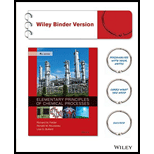
Freeze drying is a technique for dehydrating substances at low temperatures, thereby avoiding the degradation that may accompany heating. The material to be dried is cooled to a temperature at which all of the water present turns to ice. The frozen substance is then placed in a vacuum chamber and may also be subjected to radiant or microwave heating; the ice in the food sublimes, and the vapor is carried off by the vacuum pump.
Steaks are to be freeze-dried in a heated chamber at 1 torr (1 mm Hg). The steaks, which contain 72% water by mass, enter the chamber at —26°C at a rate of 50 kg/min. Of the water entering with the steaks, 96% leaves as a vapor at 60°C; the remainder leaves as a liquid with the steaks at 50°C.
- Use the heat capacity data given below and additional tabulated data for water to calculate the required heat input in kilowatts.
- When large temperature changes are not involved in a phase-change operation, a reasonable estimate of the required heat transfer rate may be obtained by neglecting contributions of temperature changes to die overall process enthalpy change (i.e., by taking only phase changes into account). Moreover, it is often reasonable to use any available values of latent heats, neglecting their dependence on temperature and pressure. In the case of the freeze-drying process, the approximation might be to calculate only the heat needed to melt all die water and vaporize 96% of it, using latent heats at the normal melting and boiling points (Table B.l) and neglecting the heat required to raise the temperature of the meat and water. What percentage error in the calculated value of Q would result from this approximation? Take the value determined in Part (a) to be exact. (c) Many substances, such as food and drugs, spoil if exposed too long to high temperatures (which accelerate rates of degradation) or to liquid water (which provides an environment for growth of microbial species that cause degradation). Also, rates of evaporation and sublimation increase as
temperature increases and pressure decreases. Use those observations to construct a one- paragraph explanation of how freeze-drying works and the reason for each step of the process. (For example, why is the sublimation done in a vacuum chamber?) Your explanation should be clear to someone with a nontechnical or nonscientific background.
Want to see the full answer?
Check out a sample textbook solution
Chapter 8 Solutions
Elementary Principles of Chemical Processes, Binder Ready Version
Additional Engineering Textbook Solutions
Process Dynamics and Control, 4e
Elements of Chemical Reaction Engineering (5th Edition) (Prentice Hall International Series in the Physical and Chemical Engineering Sciences)
Introduction To Finite Element Analysis And Design
Starting out with Visual C# (4th Edition)
Using MIS (10th Edition)
 Introduction to Chemical Engineering Thermodynami...Chemical EngineeringISBN:9781259696527Author:J.M. Smith Termodinamica en ingenieria quimica, Hendrick C Van Ness, Michael Abbott, Mark SwihartPublisher:McGraw-Hill Education
Introduction to Chemical Engineering Thermodynami...Chemical EngineeringISBN:9781259696527Author:J.M. Smith Termodinamica en ingenieria quimica, Hendrick C Van Ness, Michael Abbott, Mark SwihartPublisher:McGraw-Hill Education Elementary Principles of Chemical Processes, Bind...Chemical EngineeringISBN:9781118431221Author:Richard M. Felder, Ronald W. Rousseau, Lisa G. BullardPublisher:WILEY
Elementary Principles of Chemical Processes, Bind...Chemical EngineeringISBN:9781118431221Author:Richard M. Felder, Ronald W. Rousseau, Lisa G. BullardPublisher:WILEY Elements of Chemical Reaction Engineering (5th Ed...Chemical EngineeringISBN:9780133887518Author:H. Scott FoglerPublisher:Prentice Hall
Elements of Chemical Reaction Engineering (5th Ed...Chemical EngineeringISBN:9780133887518Author:H. Scott FoglerPublisher:Prentice Hall
 Industrial Plastics: Theory and ApplicationsChemical EngineeringISBN:9781285061238Author:Lokensgard, ErikPublisher:Delmar Cengage Learning
Industrial Plastics: Theory and ApplicationsChemical EngineeringISBN:9781285061238Author:Lokensgard, ErikPublisher:Delmar Cengage Learning Unit Operations of Chemical EngineeringChemical EngineeringISBN:9780072848236Author:Warren McCabe, Julian C. Smith, Peter HarriottPublisher:McGraw-Hill Companies, The
Unit Operations of Chemical EngineeringChemical EngineeringISBN:9780072848236Author:Warren McCabe, Julian C. Smith, Peter HarriottPublisher:McGraw-Hill Companies, The





